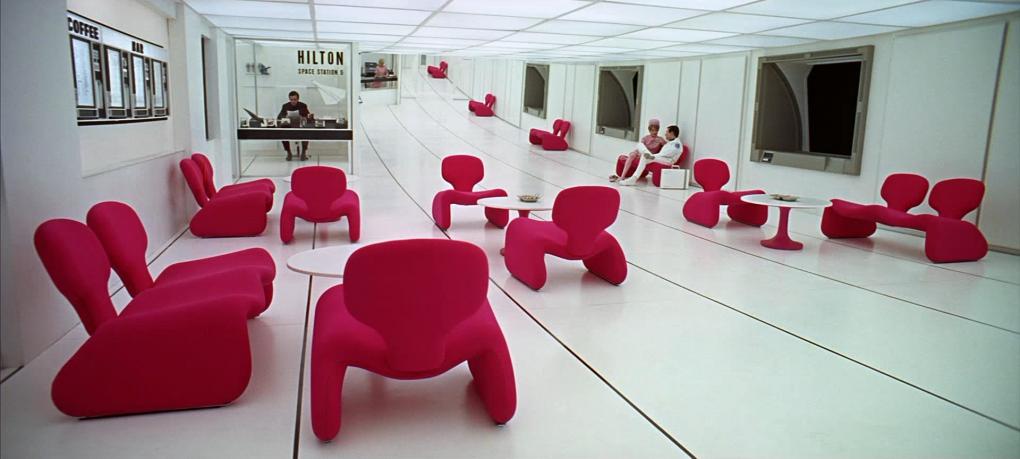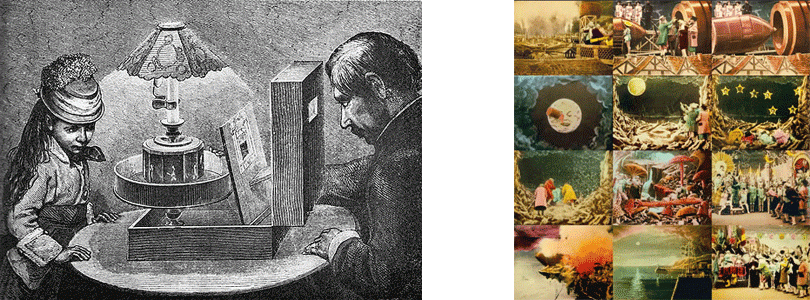
On the deck of the space station in Stanley Kubrick’s 2001: A Space Odyssey (1968), the futuristic Djinn chairs of Oliver Mourgues dominate the scenographic space of the image. In the traditional view of film, the production design of 2001 concerns only the physical design of the set and the set dressing. But aren’t the totality of the image and the animated sequences in the work also examples of production design? And what about computer generated images and the overall design of animated movies? If not production design, what is the holistic design of transmedia and visual fictions based on imaginary worlds?
We have, in other words, been thinking about production design in a much too narrow sense. In this paper, I will argue that we need to extend the present understanding of production design to include a broader range of formats and production techniques. Production design has often been associated solely with physical set design and film architecture, but production design is also an essential function in animation film, as well as in other time based-media formats. We therefore need to expand our concept of production design, also because it is becoming increasingly central in contemporary film and television productions through the use of digitally created elements incorporated with live action images.
My aim, therefore, is to raise awareness of production design analysis and to advocate a formal, poetic method that views stylistic patterns as traces of artistic decision-making and problem solving (Bordwell, 2005:249). The purpose, or telos (Carroll, 2003:139), of production design, is primarily the creation of story world, stimulating imagery, style, visual metaphor and the extension of character traits in physical or virtual scenographic space supporting dramatic action and story idea. This paper will investigate how these essential concepts connect to ideas of design and stylistic functions and how production design expresses itself in visual fiction. Production design functions mostly in the service of the story, in the vision and creation of the illusion of verisimilitude and fantasy (LoBrutto, 1992:3). It is the nature of this illusion when skillfully created and filmed, to be experienced by the audience as the ‘natural’ context of the story and thus its construction becomes ‘invisible’. The idea of invisible design however is problematic when one wants to engage in the analysis of production design as it is when experiencing for instance new media story world based works. Production Design also has extradiegetic qualities. Various strategies used to understand production design will be presented.
Understanding production design practice
To understand production design, it is beneficial to have a concept of what the production designer does. C.S. Tashiro, in his work on production design and the history film, describes the industrial practice of the production designer as supervising the overall look of a film, working in close collaboration with directors, cinematographers and their own staff of designers ( 1998:3). One could add that the production designer as head of the art department is involved in creating and assembling design elements included in the overall cinematic production. Production design decisions are related to the construction of space, look and feel of the cinematic work. Though Tashiro does not include specifically animation in his presentation of the subject, this description applies equally well. In order to understand what the production designer does and, consequently, what production design is, it is crucial to have an understanding of cinema and how the moving image is made. Essentialists in film theory as Siegfried Kracauer and André Bazin have emphasized the photographic quality of film as the hallmark and aesthetic basis of the medium, thereby differentiating it from other related art forms, such as painting and theatre. Accordingly, the common concept of production design is mostly shaped by this understanding of film and cinema as a photographic reproductive medium. For early film design thinker and art director Léon Barsacq, the function of film design was the creation of the reality effect and thus the illusion that real objects were being photographed (Barsacq 1976:7). Tashiro, among others, basically accepts this premise as a point of departure in discussion and analysis of production design. To include the variety of cinematic genres, aesthetics and modes of production exercised it is beneficial to adopt American philosopher Nöel Carroll’s view that it is not adequate to think of moving images as film, that is referring exclusively to the celluloid-based medium and its mode of representation (Carroll, 2008:66–67). Film, or rather the moving image itself, is not an exclusive indexical media-technology of mechanical reproduction nor has it ever been so. Indeed, the first projected moving images were the glass-painted praxinocope animations of Charles-Émile Reynauds, and the first fiction films of George Méliès were studio-based, using a mixture of techniques and highly manipulated, similar to modern film. (See figure 2).

It is more to the point and more productive, to reflect on moving images as a sort of time-based pictorial art, simulating story world and dramatic action, or as Manovich suggests, a subgenre to painting (Manovich 2001:295). If we accept this perspective, we can include various aesthetics, technological approaches and modes of production in our understanding of what production design is and what the production designer does1. This broad concept of the subject to include animation, film, television-series, optical toys and neighbouring genres as games and virtual reality creates a minor but nevertheless significant modification to the idea of what the production designer does. A modified description of the work of the production designer could be read as the following: In collaboration with other above-the-line functions, the production designer develops the story world, the visual style and spatial design for the moving image. It is here understood that the environment represented in the image is built from and staged as physical, digital or mixed elements and framed by a real or virtual camera. Significant production designers such as Alex McDowell work in animation, live-action and hybrid formats as Fight Club (1999), Minority Report (2002), Corpse Bride (2005) and Watchmen (2009). Using this broad approach, we can better appreciate the production design skills of Harley Jessup in James and the Giant Peach (1996), Monsters, Inc. (2001), Ratatouille (2007), and The Good Dinosaur (2015); of Dante Ferretti (Salò, 1974), The Name of the Rose (1986), The Adventures of Baron Munchausen (1988), Interview with the Vampire (1994) and Shutter Island(2010); and Gemma Jackson in John Adams (2008), Game of Thrones (2011–) and King Arthur: Legend of the Sword (2017–).
In traditional film production, the above-the-line functions are the director, producer and screenwriter, production designer and in live-action film, the cinematographer. The production designer is in charge of the art department which usually includes art directors and other designers. The workflow of each production will be unique, ideally production designers would be involved with writers in the early stages of developing a television series and in the total design of an animation production. The ideal for production designers as Alex McDowell is to be included in the early development of any production allowing for story and design to interweave (Wille 2015).
Designing design
If the term production design, as Tashiro suggests, means that the designer has an industrial approach or process (Tashiro 1998: 4), then the duality of the production design artefact is best instigated in the term scenography and in the German term Szenenbild. The first syllable of the words referring to a spatial and the final to a graphical dimension. Production design as artefact, lives a double life; as both a two-dimensional moving image of graphic quality and as a representation of a three-dimensional physical set. Most animation techniques consist of images based on graphical design. Designers working with 3D animation techniques also have to
consider the manner in which digitally developed design elements appear two-dimensional when framed by the virtual camera.
To understand production design, the ambiguous nature of the word design itself calls for further exploration. In current design research, the term design is understood in a very broad sense. Design researchers talk of an extended design concept to include traditional fields such as graphic, fashion and furniture design, as well as more methodological and communicative territory such as service and interaction design as well as critical and strategic design (Buchanan 2001). In addition, design can be understood as a process in which a design idea, sketch, plan or prototype is made into a functional design artefact. All of the stages and connecting processes are, however, also referred to as design. As design professor John Heskett put it; Design is to design a design to produce a design (Heskett, 2005:3). This is true of production design as well.
The phenomenological structure of production design is comparable to the structure of the screenplay (Wille 2015). Italian filmmaker and philosopher Pier Paolo Pasolini understands the screenplay as a diachronic form, which as a textual structure suggests the structure of film (Pasolini, [1965] 1988). The narrative content of the movie or any other form of visual fiction is developed and exists in a number of different containers as ideas, treatments or screenplay drafts. However, most of the manifestations of the process go into the wastebasket when the production is completed (Price 2013: 19). Inspired by the technical language of design and architecture, the screenplay is often described using metaphors as ‘the blueprint of a film’ and though screenplays are occasionally published and read for pleasure, they are, for the most part, regarded as a planning tool with no justifiable existence or function once the movie is completed. The same is basically true of design sketches and prototypes, though concept art and design bibles are occasionally published or available online. The reader of screenplays must be able to visualize the text as something wanting to become a moving image and in the same manner, the observer of any production design concept, model or drawing must appreciate the dramatic narrative context for which it is created.
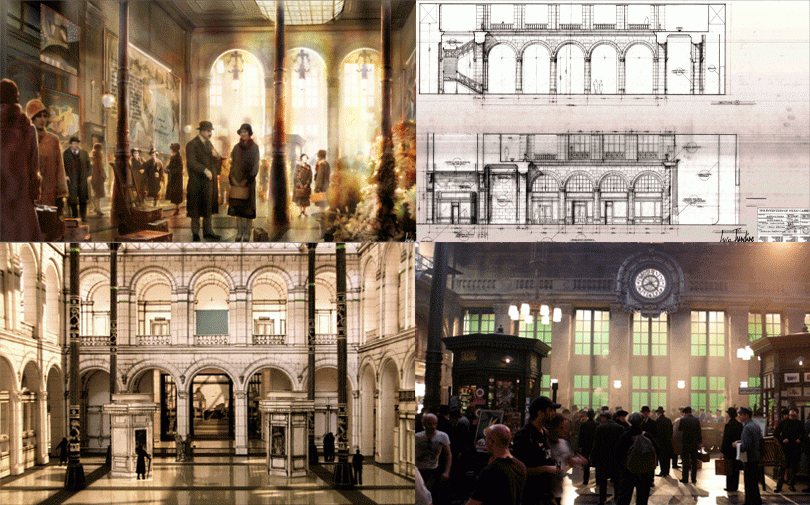
When analysing production design, one must clarify whether the subject is the design process or different incantations of design within that process. (See figure 3). The focus of the bulk of production design analysis is on the artefact, understood primarily as the physical design of the set. But this is not a given. The analyst could direct his or her attention to how design ideas, sketches, concepts, models, concept artworks, or technical drawings were developed by individual or teams of designers for specific productions, just as he or she could look at the design process, communication, collaboration or organization in the social design world or in the art world, of movie making (Becker 2008).
Analysing production design - Breaking it down
Production design is developed and created for different formats of moving images, using different appropriate techniques. In the process of making moving images, production design exists as ideas, sketches, concepts and prototypes. From the point of view of user perception or observation, however, the first production design the audience experiences is the graphical surface of the moving image. We could think of this as the first level of the design, with the second level then being the physical or virtual design artefact represented in the image. Subsequently, the third level is the sketches and prototypes involved in developing the physical and visual design artefacts. When we look at production design in the finished work of the first level, we seek traces that reveal the decision-making of the previous levels. When analysing design in moving images, an obvious starting point is to define basic techniques used in the production and subsequently look for stylistic patterns and visual ideas present in the work. For the most part, it is easy to identify applied techniques and, for instance, distinguish live-action film from hybrid and animated movies. It is, however, increasingly difficult to track techniques in moving images that mix live-action and computer-generated material. It can be challenging even with older films to define whether scenes were built from shots of pure representation, using matte painting, models or created using analogue composite techniques. One famous mistake was André Bazin’s praise of Orson Welles’ use of deep-focus cinematography in Citizen Kane (1941), whereas the illusion of depth was created using analogue composite techniques in an optical printer (Carringer 2008: 99). Local scenes in Italian neorealist films were shot in studios and yet praised for location shooting (Barsacq 1976: 105). In complex cases, a point of departure would be to conduct a visual breakdown in order to identify the source of various elements of the image or the scene. In the case of the aesthetic ideal in modern filmmaking being photo-realism, the different parts of mix-media images is none the less difficult to separate. As Stephen Prince writes (2015: 145):
Composite shots blend live action with hanging miniatures, matte paintings, and process photography, making production design more than set. The built environment for a feature film consists of the physical set and props as various kinds of composited imagery that extend, elaborate, and fill in what was not built directly for live action.
Modern digital movie production is, or can be, an art of the fragment.
As with the image created using composite techniques, the scenographic space of the scene can be broken down into different scenic layers. C. S. Tashiro suggests a system of breaking down the image into spheres of proximity that he refers to as circles of feeling: beginning with design closest to the body of the actor, such as makeup, costume and personal props, and moving into interior dressing, exterior location and nature etc. (1998:17-38). The layers constructing the scenographic space must blend vertically in the scene and horizontally with adjacent scenes and, in the end, blend with the total look of the work - and, in transmedia, with any related works played out on other media platforms. I have addressed this multiplicity as a characteristic of production design and also suggested a horizontal strategy of viewing visual patterns as time-based graphical design and a vertical strategy of engaging the spatial dimension as the (physical or virtual) environment designed.
A typical challenge for a production designer is to ensure that shots from a real, simulated or studio-based outdoor setting match any interior studio or location shots. Architectural features such as doors or windows that allow physical interaction and might be visible from both an outdoor and indoor perspective are particularly important as they are basic components in our story world orientation. From the point of view of ecological perception and cognitive theory they connect or block other key components as containers (houses and caves) and paths (Grodal 2009). In addition, architectural features that are visible as both interior and exterior are important in creating the illusion of consistency in the story world.
The production design process creates guidelines for the numerous aspects of the actual production of the physical or digital elements that will be visible in the finished film. Under the instruction of the production designer, the art director is responsible for the architecture of the set and the set-dresser for the interior design. Matte paintings, props and costumes are produced separately by different designers. One must be able to identify these parts and explain how and if they work together and how they might possibly enrich one another. Of course, production design might work consciously against the idea of spatial unity in the design. Lars von Trier exposes the technological body (Barker, 2009) of movie production in films such as Dogville (2003) and Manderlay (2005) by showing a fragmented set and the studio surrounding it (see figure 4). Classical mainstream productions, however, mostly hide their own construction, aiming for the illusion of photo-realism and coherency in the production design and visual universe.
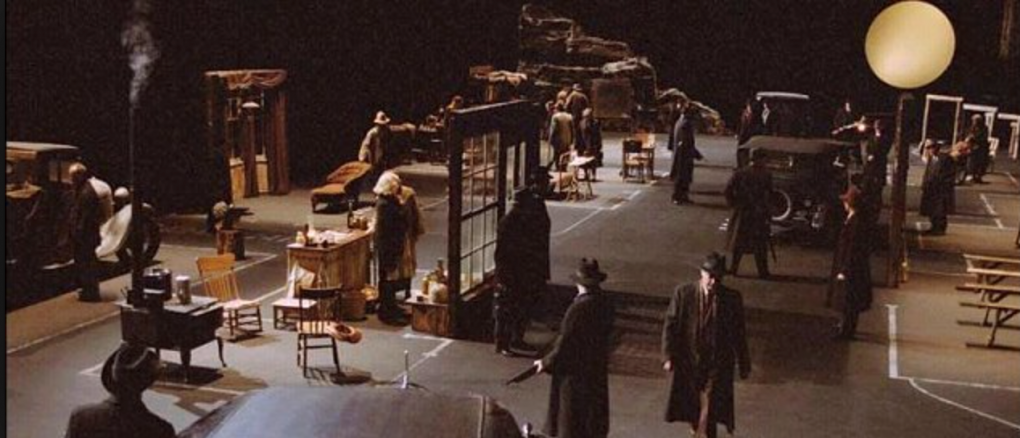
Looking at cinematic space, David Bordwell suggests that shot space be differentiated from editorial space in order to highlight, on the one side, the pictorial qualities of the shot and, on the other, the space constructed in the montage of shots. In addition to the visual cues, the illusion of space is also constructed by on- and off-screen, diegetic and non-diegetic sonic traces (Bordwell 1985; 113-120). The emphasis on space as an editorial construct may detract attention from the style of the actual space represented. To avoid this ‘blindness’, one could differentiate between the style of cinematic representation and the represented style of the design or architecture.
In his work on art direction and production design in classis Hollywood, Juan Antonio Ramírez simply uses historical architectural styles to classify style in production design to range from Mesopotamian, Greco-Roman and other architectural styles of the Antiquity through medieval, renaissance and baroque to art deco, international style and surrealist architecture in musicals (Ramírez 2004:114-201). This is useful as a point of reference, but does not take into account the style of representation or the overall cinematic view. Affron and Affron (1995) suggest a taxonomic system for classification, including five different strategies in set design. These are set as 1) denotation, 2) punctuation, 3) embellishment, 4) artifice and 5) narrative. The set as denotation is defined as a neutral set dominated by the action and intrigue of the movie. If the expressive function in films whose sets are denotative is carried through dialogue and action, the punctuated set allows local dominance of scenic as active elements of structure, genre, character or theme. (Affron & Affron 1995: 51-60) Think of signs of style and genre, ex. Film noir, in opening shots or local sequences, or of thematic trace trays in notable single sets. Affron & Affron mentions C.C. Baxter's depersonalized and alienating office in Billy Wilder’s The Apartment (1960) as an example of denotation. Set as embellishment is the historical or mimic set, as in many of Ramírez’s categories. Think of Ben-Hur (1925, 1959, 2016) or film imitating pictorial art as Vincent Minnelli’s van Gogh biopic Lust for Life (1956), Peter Webber’s Girl with a Pearl Earring (2003) or modern architecture. Set as artifice is the dominating artistic set in what can be perceived as invited realities, as in Das Kabinett des Dr. Caligari (1920), Metropolis (1927), Things to Come (1936), Blade Runner (1982) or even Gold Diggers (1933, 1935, 1937), whereas for set as narrative, set and narrative seem to work as an inseparable unit, as in a series of Hitchcock’s films: Rope (1948), Rebecca (1940) and Rear Window (1954). To clarify some of the differences in this system one could compare the modern office space represented in Jacques Tati’s Playtime (1967) to the office in The Apartment. In The Apartment the office is a memorable decoration underlining the theme and environment of the film and thereby placing it in the category of punctuation, the office in Playtime, on the other hand, is part of a unified total design dominating the film as described in Affron & Affron as artifice. However, the system is not bulletproof. It is for instance possible see the set of Rebecca not only as a narrative but also as punctuation highlighting genre, embellishment imitating architectural style and artifice dominating narrative. The same goes for Playtime. It is possible to see it as both set as artifice and as set as narrative.
Functions of style in production design
If the distinctions separating Affron & Affron's taxonomic categories are not always clear, Bordwell elsewhere seems to suggest four categories, or functions, in handling cinematic style, that can also be useful when analysing production design (Nielsen 2004). Bordwell’s functions are described as: 1) The denotative design prioritises recognisable space, whereas 2) expressive design amplifies character emotion and audio-visual sharp contrasts. 3) The decorative function orientates itself towards lyrical textures, patterns, colours and ornamental figures, in a way, hampering the narrative drive (Grodal 2009: 237). 4) The symbolic function uses abstraction and visual metaphor, touching the thematic content of the story. A clear example of symbolic function is seen in the recent James Schamus adaptation of Philip Roth’s Indignation (2016). The flower motif on the wallpaper of old Olivia’s mental institution functions both as a reminder of the flowers she arranged at the bedside of her lover, Marcus, when he was hospitalized and as a sign of love and death in their tragic story. The motif is also repeated in her dress. In other words, the motif is echoed in costume, prop and decoration, creating a strong metaphor in the visual story and design. Critics might find the effect too obvious, but as Bordwell mentions, the way the flower decoration is used as motif on the wallpaper of the mental institution at the closing of the movie questions if the story is a mental construct of Olivia's (though most of the story is restricted to Marcus’ range of knowledge) or rather, if the room “Caligari-like, is a total projection of her memory? More likely, it’s objectively there but triggers her recollection of Marcus.” However, we are never sure (Bordwell, 2016). (See figure 5).
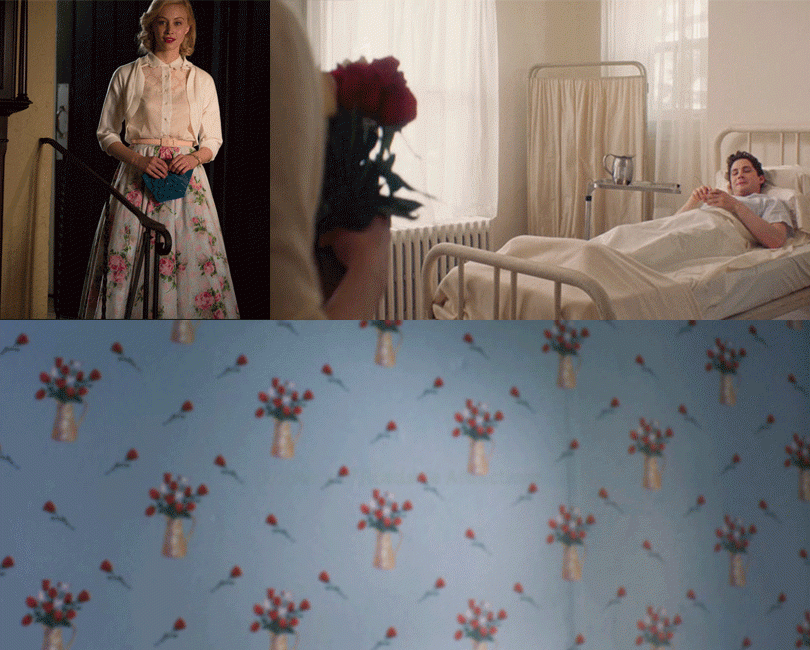
Of course, a production might benefit from a varied use of all functions. The denotative function is orientated towards objects, agents and spatial orientation in three-dimensional space, the expressive function toward subjective experiences, the decorative towards tactile and other sensation and the symbolic function supporting narrative themes and often serving as background for character development and dramatic action. Scenes and sequences in a cinematic work might shift between functions (Grodal 2003: 44) or a cinematic work, as a whole, might be dominated by one function dependent on genre or style, such as the visual contrast of expressionism in the aforementioned Das Kabinett des Dr. Caligari, the works of Tim Burton or more recent Jennifer Kent’s Babadook (2014). Whereas Tom Ford’s A Single Man (2009), Todd Hayne’s Carol (2015) or In the Mood for Love (2000) by Wong Kar-wai, the tactile and decorative qualities of the lyrical film are emphasized. In that way, one can perceive design strategies in the moving image as negotiations involving different functions to trigger different perceptual, emotional, sensational or intellectual effects.
Summing up, the functions described by Bordwell are the denotative, the expressive, the decorative and the symbolic function. The denotative focused on representation of objective perception of the recognizable world. Expressive functions are linked to subjective emotional effects. Decorative effects are linked to sensational and tactile experience, and the metaphorical are linked to intellectual effects. Both Bordwell and Tashiro can be used to gain insight on the visual elements and their function on moving images.
When analyzing production design, one can look for the visual metaphor running as visual subtext behind the action, at times in the actual background, for example in the wallpaper of the set decoration as we saw in Indignation. When looking at objects on screen, the reality of them is strengthened by visual compensation in ways related to the decorative function. For instance, highlighting softness of a fabric by placing it on other soft material. Tashiro mentions how blueberries, cream, pears, wine and cheese presented during the fatal scene in Bo Widerberg’s Elvira Madigan(1967) and the schimmer of silk and damask in the opening of Luchino Visconti’s L´innocente (1979) are meant to appeal as substitutes for taste, touch and even stimulating olfactory effect (Tashiro: 20-21).
Expressive functions in production design can be seen in the overall style and mood or the scenes expressing subjective feelings. As suggested, the denotative function of production design prompts recognisable space in which arrangement of scenic elements as props, furniture and set not only enable dramatic action and spatial orientation, but also cues perception of time, place, period, environment and characterization essential for the reading and understanding of the work. Some designers might have preference for constructions of recognisable space, others towards sensation, feeling or metaphor. The art production design however, lies in choosing from, manipulating and combining stylistic functions and effects supporting or otherwise relating to story content and dramatic action. Sometimes enriched design experience might be of more importance than story in highly artistic films and in productions relying on immersion in imaginary worlds as the ones found in Star Wars, The Matrix or Lord of The Rings. This suggests a shift from the analysis of linear narrative structure in traditional film and other media to a focus on the fictional worlds. As Mark Wolf (2012: 12) puts it:
A focus on the worlds themselves, rather than on the individual narratives occurring within them or the various media windows through which those narratives are seen and hear, becomes more interesting the larger the world that one is considering, and can provide a more holistic approach to analysis, especially when the worlds in question are transnarrative and transmedia ones.
Tracking stylistic patterns and design ideas and rewriting design
French film theorist Anne Souriaus (mainly associated with the theory of diegetic) identifies three general functions of set design that effect the reading or experience of a set presenting a useful compass when trying to navigate the different means of expression in production design. Souriaus sees set design or décor (here extended to production design) formed by a 1) decorative function, a 2) location function and a 3) symbolic function (Affron & Affron 1995: 36). The decorative function makes the image pleasing or appealing, the location function sets up clues on where and when the action unfolds, and the symbolic function reveals ideas and feelings. These relate to the description of functions described by Bordwell discussed in the previous section of this paper; the location function resembling the denotative and the symbolic function resembling the metaphoric function. All three or four functions relate to story content. Hiding construction and not dominating narrative, but rather supporting story and reflecting character traits is often thought of as the ideal function of production design elements. Production design then works as a visual subtext or subliminal factor affecting viewer reception, more or less beyond consciousness (Prince 2015: 144).
Narration and symbolism in the design might appear to be traceable in the set in various ways and thus visible in the moving image. For example, Steven Jacobs refers to Walter Benjamin’s concept of dwelling in his analysis of design in Hitchcock’s houses. In Benjamin´s critique and in the typical horror story of, for instance, Poe, the collected items of the bourgeois home seem to take on their own life slowly suffocating the inhabitants. (Jacobs 2007: 36).
Production designer Sylbert explains how, as part of his method, he rewrites the screenplay in visual terms to reflect dramatic structure through the design elements at his disposal (Ettedgui 1999: 40). As a starting point for the design concept of the Lowenstein apartment in Barbara Streisand’s The Prince of Tides (1991), Sylbert pulled a list of adjectives describing characters from the script and then in an opposite column added corresponding material and styles. In analysis, this method could be reversed by translating material and styles into adjectives describing characters.
The designers of the modern animation classic Up (2009) used the effect by not only relating specific objects to character’s and their backstories, but also repeating the basic geometric shapes in character design of each. The main character, Carl, is designed using quadratical shapes and his wife Eleanor is based on circular shapes. Carl is square, in more than one sense; his costume, personal props and furniture repeat his basic temper and design. Carl uses squarish glasses and belt buckle; and he sits in a boxlike armchair under a cube shaped lamp. After Eleanor’s death, some, but not all, of her round shaped props and furniture disappear from the interior design and dressing of what is now Carl's home. Her, now empty, drop-shaped chair functions as a visible reminder of her absence. Towards the end of the story, some of Eleanor’s missing items and additional possessions reappear in Carl's living room. For instance, a squarish rug is added on top of Eleanor’s previously missing round carpet. In the beginning of the story, the room is in balance, after Eleanor’s death it is emptied, and in the end, it is filled again finding a new kind of balance. (See figure 6).
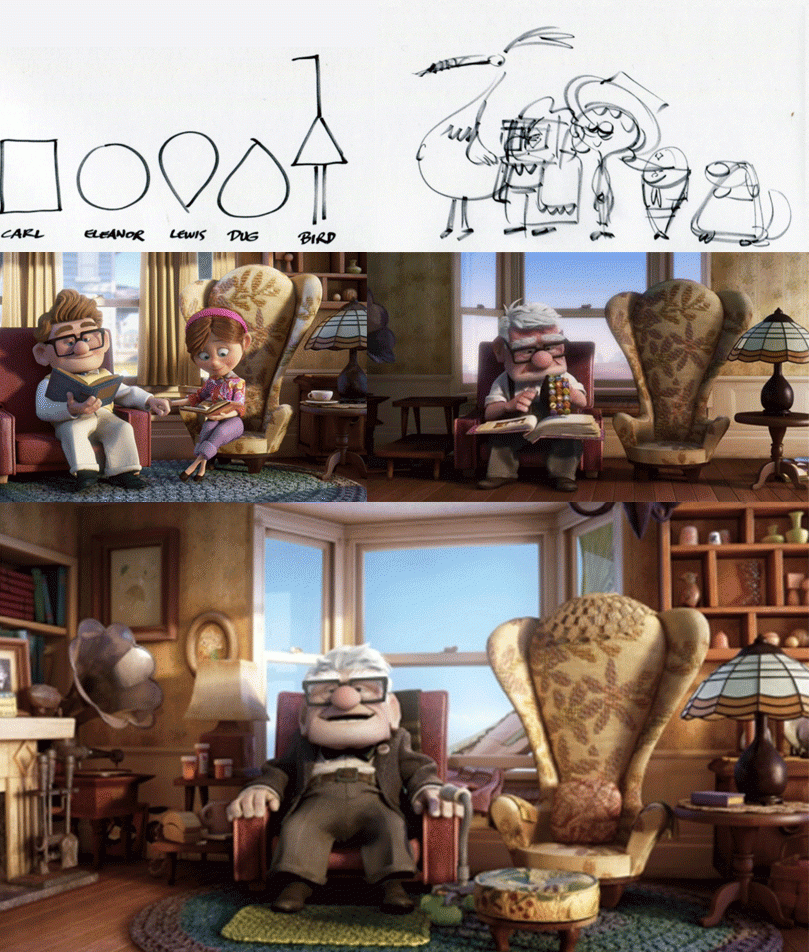
Tashiro suggests four basis attitudes to the cinematic frame and space: open/empty, open/full, closed/empty, and closed/full (1998; 46). Further basis parameters could be added to the construction of cinematic space; Bruce Block for instance differentiates between deep, flat and ambiguous space (Block 2008). The dominating idea in the interior design of the living room in Carl's home is using the shapes that refer to the character and moving from emptied to filled space.
A design idea can be perceived as repeated motifs in the moving image to create metaphor as with the flowers in Indignation, or it can focus our attention on the temperament of a character or even the absence of a character as in Up. A production design idea is strong when it reflects the mood of the story, the dramatic idea or premise of narrative content. Analysing design from this perspective, it is possible to trace probable decisions backwards through planning and production of the cinematic work. In the history of film theory however, film design or even the thought of visual planning has been considered problematic or even suspect.
Production design aesthetic and ideology
Film theory has been largely coloured by a preference towards realism. This preference has, to some extent, restricted analysis of set and production design. In the works of German-American art and film theorist, Siegfred Kracauer, the non-realist studio approach in filmmaking was not only judged as aesthetically problematic but also ideologically suspect. The idea that the filmmaker could pre-shape and control the moving image before shooting, and possibly from another standpoint than realism, was seen, at the least, as antithetical to the essentialist concept of cinematic aesthetic and, at most, as being a problematic symptom of totalitarianism. (Kracauer 1947: 76). To German-American art historian Erwin Panofsky, the idea that one could plan and graphically pre-stylize moving images was contrary to the basic nature of the filmic medium (Panofsky 1983:166-167). From the same line of thinking, but resulting in even more ambiguous conclusions, French critic André Bazin linked his understanding of mise-en-scene to a more realistically democratic and less manipulative form of filmic staging by emphasising composition in the depth of the cinematic space (Bazin 2005:35-36). Echoes of realist anti-formalist approaches are also reflected in both historic and contemporary cinematic movements. In Italy, the neorealist movement was understood as a reaction to escapist studio production. French Nouvelle Vauge and other New Wave movements across the world were basically understood in the same way. In Denmark, the Dogma95 movement rejected studio and costume design. Simply put, studio production was seen as betraying the realist essence of cinema and documentary-style production that was freeing cinema from economic, production-related and aesthetic restrictions. This view was questioned by French writer and film historian George Sadoul: “The dichotomy between the studio and the set, the antithesis between Lumiére and Méliès, are false oppositions when one attempts to find in them a solution to the problem of realism and art. Films completely outside time have been shot outdoors; completely realistic films have been shot in the studio” (Barsacq 1976: 121).
Another aspect of the realist prejudice in film aesthetic is the criticism of graphical decorative qualities. American architect Myerscough-Walker commented in 1941 on the different approach used by the architect and by the painter to motion picture set design and stage décor: “The painter composes the picture as the camera will see it, but the architect designs a building which can be photographed.” Myerscough-Walker continued that the painter, “like a woman”, was concerned with the emotional aspects, whereas the architect, “like a man”, was concerned with the truth of things. He then concluded that it is impossible to be a good art director without being a good architect (Ramírez 2004:45). Beneath the stereotypical view of the female painter as being in touch with emotion and the male architect concerned with essence, lies the observation that the approach to cinematic design is (at least) two sided. As seen in the Myerscough-Walker quote, decorative styling or design was associated with female qualities, distracting one from the truth of things.
New feminist film critic Rosalind Galt, in her work on the concept of pretty in moving images, notes how visual qualities such as colourful, carefully composed, balanced, picturesque and ornamental are related to the surface of the image and, as a consequence, to images without depth. and negative qualities such as empty spectacle and painted pictures (Galt 2011: 8–11). The aesthetic assumptions of modern design and architecture are biased when confronted with the decorative and non-functional. The ornamental is associated with such negatives as crime and death by influential critics like Adolf Loos and Theodor W. Adorno (Galt, 2011: 111). While modern design and architecture declare “form follows function” along with Louis Sullivan, production design might declare “form follows story content” (Brückner 2011: 60), and is integrated in the bounding of story world. When engaging in production design analysis, one should attempt to bypass judgmental values or production-related habits associated with either the graphical surface of the image or the spatial design of the set as well as the idea of an essential realistic film aesthetic and the functionalist concepts in modern design and architecture thinking.
Conclusion
In this paper, I have outlined some of the problems that arise in analysing production design when our conception of production design is too narrow. I hope to have demonstrated, that by expanding the concept of production design, we can more clearly embrace the multiplicity of genres and existing modes of production for storytelling in time-based media. In the process, the paper engaged in discussions of definitions connected to various concepts of what constitutes cinema or, more broadly, the moving image. However, in focusing on questions of definition and of analytical systems, instead of engaging in in-depth analysis, I have chosen to use examples to illustrate and support my case. The main point has been to raise general awareness of the analytical possibilities when viewing visual style applied to time-based media and, more specifically, production design in storytelling genres.
Production design expresses itself in both temporal and spatial parameters and is, for the most part, constructed three-dimensionally to be experienced in two-dimensions. I have addressed this multiplicity as a characteristic of production design and suggested a horizontal strategy of viewing visual patterns as time-based graphical design and a vertical strategy of engaging the spatial dimension as the (physical or virtual) environment designed. Borrowing from Bordwell and in part from Grodal and Souriaus, I see functions in production design as means of supporting specific effects in relation to affordance, sensation, emotion and metaphor. For instance, the denotational effect or location effect is necessary to simply set time and place, and to support the understanding of the spectator regarding navigation in space. If effects in affordance is constrained, lyrical emotions and a more subjective aesthetic may be experienced (Grodal 2009: 239). Lyrical emotions might also be supported by decorative qualities in the design. Metaphor or symbolism is then created through repeated motifs relating to narrative theme. Clues of character traits and story might work as visual subtext in costume, setting and dressing. Mood is set by the overall visual style as a negotiation involving story theme, genre, mode of production and artistic ambition. Again, design elements and story world experience might be the point in transmedia productions or works unfolding imaginary worlds pulling production design from the background to the front. Roughly speaking imaginary worlds can exist without stories, but stories cannot exist without a world (Wolf 2012: 29.) and in visual fiction the world is build largely by the designer. Basically, the visual language expresses itself through the use of contrast and affinity in the parameters available, such as colour, shape, tone, space, texture etc. In animation, production designers and/or other visual artists control these elements in detail, whereas, depending on genre and artistic ambition, designers working with live-action film and television production often place weight on spatial and environmental design. Rudolf Arnheim in “A New Laocoön: Artistic Composites and the Talking Film” bemoans the end of silent cinema. In the quietness of the silent image, visual elements could relate and communicate on the same level and “the fragment of a broken vase could talk exactly the way a character talked to his neighbor” (Arnheim [1938], 1992). Basic figures and shapes would more easily relate in the silent image. When examining production design, it might not be a bad idea to think of movies as silent and to study its imagery with the sound turned off or by looking at single frames. This procedure would enable recognition of shapes, coulure, textures, and spatial design more easily. And perhaps this method one also encourage an understanding of the importance of sound design in relation to production design, and though the intimate relation between sound design and production design has not been subject of this article, it is a basic premise of understanding film. I would like to emphasize that the visual language of production design is not silent as much as it is not invisible.
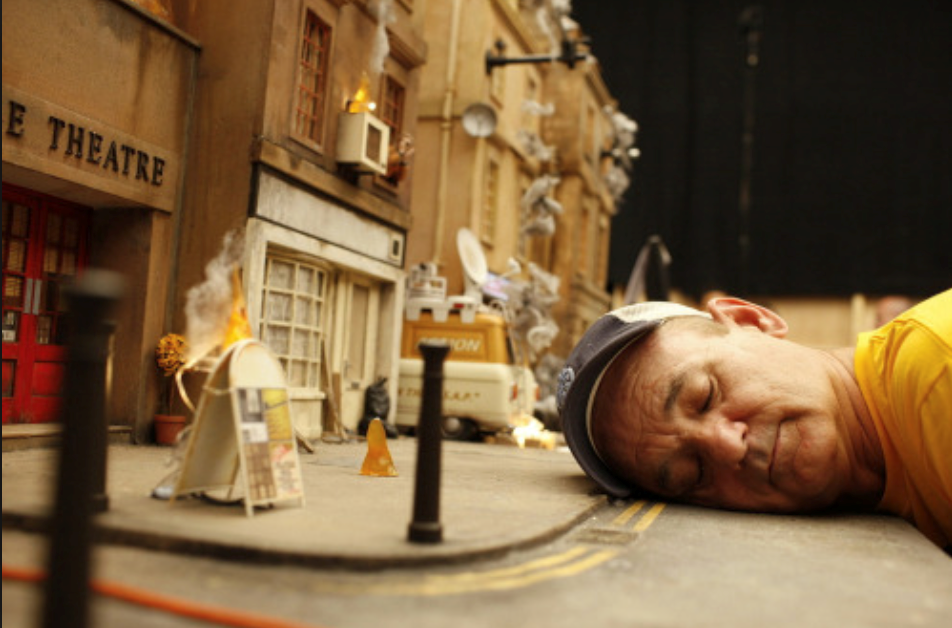
BY: JAKOB ION WILLE / PH.D., ASSISTANT PROFESSOR / HEAD OF MA PRODUCTION DESIGN PROGRAM AND BA GAME & PRODUCTION DESIGN PROGRAM / THE ROYAL DANISH ACADEMY OF FINE ARTS, SCHOOL OF DESIGN
Notes
1. Historically, production design methods were inspired by approaches in the Walt Disney studios, specifically the making of the first animated feature film, Snow White (1935). In order to achieve full visual and spatial control, the Disney-inspired methods of widespread use of painted colour storyboards and production art were used by the credited production designer William Cameron Menzies for the classic live action film Gone With The Wind (1938) (Vertrees 1989).
References
Affron, Charles & Merella Jona Affron (1995) Sets in Motion. Art Direction and Film Narrative. New Jersey, Rutgers University Press..
Arnheim, Rudolf (1992) “A New Laocoön: Artistic Composites and the Talking Film” [1938]. In: Film as Art. Berkeley and Los Angeles, California, University of California Press.
Barker, Jennifer M.(2009) The Tactile Eye – Touch and The Cinema Experience. Berkeley, University of California Press.
Bakhtin, Mikhail M.(2006) Rum, Tid & Historie – Kronotopens former i Europæisk Litteratur. Århus, Forlaget Klim.
Becker, Howard S. (2008) Art Worlds – 25th Anniversary Edition. Berkeley,
University of California Press.
Barsacq, Léon (1976) Caligari’s Cabinet and other Grand Illusions – A History of Film Design. Boston, New York Graphic Society.
Bazin, André (2005) What is Cinema, vol. 1 & 2. Berkeley, University of California Press.
Bordwell, David (1985) Narration in the Fiction Film. Madison, University of Wisconsin Press.
Bordwell, David (1989) Making Meaning: Inference and Rhetoric in the Interpretation of Cinema.London, Harvard University Press.
Bordwell, David (2005) Figures Traced in Light – On Cinematic Staging (Berkeley, University of California Press.
Bordwell, David (2016) INDIGNATION: Novel into film, novelistic film. (davidbordwell.net, August 7 2016)
Block, Bruce (2008) The Visual Story. Creating the Visual Structure of Film, TV, and Digital Media. Second Edition. Oxford, Focal Press.
Brückner, Uwe (2011) Scenography – Making Space Talk. Stuttgart, Avedition.
Buchanan, Richard (1992) “Wicked Problems in Design Thinking”. In: Design Issues, vol. VIII, no. 2, Spring.
Buchanan, Richard (2001) “Design Research and the new Learning”. In: Design Issues, vol. 17, no. 4.
Carringer, Robert L.(1996) The Making of Citizen Kane. Berkeley, University of California Press.
Carroll, Noël (2003) Engaging the Moving Image. New Haven & London, Yale University Press.
Carroll, Noël (2008) The Philosophy of Motion Pictures. Malden, Blackwell Publishing.
Ettedgui, Peter (1999) Production design & Art Direction. Hover, RotoVision.
Galt, Rosalind (2011) Pretty – Film and the Decorative Image. New York, Culombia University Press.
Grodal, Torben (2009) Embodied Visions. Evolution, Emotion, Culture, and Film. New York, Oxford University Press.
Jacobs, Steven (2007) The Wrong House: The Architecture of Alfred Hitchcock. Rotterdam, 010 Publishers.
Hauser, Tim & Doctor, Pete (2009) The Art of Up. San Francisco, Chronicle Books.
Kracauer, Siegfried (2004/1948) From Caligari to Hitler: A Psychological History of the German Film[1948] Princeton, New Jersey, Princeton University Press.
Kracauer, Siegfried (1997/1960) Theory of Film – The Redemption of Physical Reality. Princeton, New Jersey, Princeton University Press.
LoBrutto, Vincent (1992) By design: Interviews with Film Production Designers. Westpoint, Praeger.
LoBrutto, Vincent (2002) The Filmmakers Guide To Production Design. New York, Allworth Press.
Manovich, Lev (2001) The Language of New Media. Cambridge, Massachusetts, The MIT Press.
Manovich, Lev (2006) “Image Future”. In: Animation: An Interdisciplinary Journal, vol. 1, no. 1: 27.
Nielsen, Jakob Isak (2004) “Bordwell on Bordwell: Part II – Functions on Film Style.” In: 16:9 nr. 8.
Pasolini, Pier Paolo (1988/1965) “The Screenplay as a ‘Structure That Wants to be Another Structure’”. In Hertical Empiricism. Indiana, Indiana University Press.
Prince, Stephen (2015) ”Hollywoods Digital Back Lot, 2000-present”. In Fischer, Lucy (ed): Art Direction and Production Design. London, I.B. Tauris.
Price, Steven (2013) A History of the Screenplay. London, Palgrave MacMillan.
Ramíez, Juan Antonio (2004) Architecture for the Screen – A Critical Study of Set Design in Hollywood’s Golden Age. London, McFarland & Company, Inc., Publishers.
Tashiro, Charles Shiro (1998) Pretty Pictures – Production Design and the History Film. Austin, University of Texas Press.
Timmer, Andreas Arnold (1999) Making the Ordinary Extra-Ordinary: The Film-Related Work of Saul Bass. Ph.D. Thesis.
Vertrees, Alan David (1989) “Reconstructing the ‘Script in Sketch Form’. An Analysis of the Narrative
Construction and Production Design of the Fire Sequence in ‘Gone with the Wind’”. In: Film History, vol. 3, no. 2.
Wille, Jakob Ion (2014) Film som Design – Design af Levende Billeder i Film og TV-serier, Ph.D. Thesis, Copenhagen Business School & Det Kongelige Danske Kunstakademis Skole for Design.
Wille, Jakob Ion (2015) “Shaping Dreams: Design Ideas and Design Fiction in Movie and Television Production Design”. In: Artifact, Vol 3, No 4.
Wolf, J.P Mark (2012) Building Imaginary Worlds – The Theory and History of Subcreation. New York, Routledge.
Suggested citation
Wille, Jakob Ion (2017): Analysing production design: Positions and approaches. Kosmorama #268 (www.kosmorama.org).
